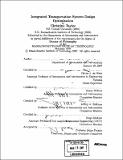| dc.contributor.advisor | Olivier de Weck. | en_US |
| dc.contributor.author | Taylor, Christine P. (Christine Pia), 1979- | en_US |
| dc.contributor.other | Massachusetts Institute of Technology. Dept. of Aeronautics and Astronautics. | en_US |
| dc.date.accessioned | 2007-08-29T20:39:14Z | |
| dc.date.available | 2007-08-29T20:39:14Z | |
| dc.date.copyright | 2007 | en_US |
| dc.date.issued | 2007 | en_US |
| dc.identifier.uri | http://hdl.handle.net/1721.1/38644 | |
| dc.description | Thesis (Ph. D.)--Massachusetts Institute of Technology, Dept. of Aeronautics and Astronautics, 2007. | en_US |
| dc.description | Includes bibliographical references (p. 173-178). | en_US |
| dc.description.abstract | Traditionally, the design of a transportation system has focused on either the vehicle design or the network flow, assuming the other as given. However, to define a system level architecture for a transportation system, it is advantageous to expand the system boundary during the design process to include the network definition, the vehicle specifications, and the operations, which couple the vehicle(s) and the network. The integrated transportation system formulation developed in this thesis examines these fundamental components by classifying the decisions required to define them and concurrently optimizing the entire design problem, resulting in a more efficient transportation architecture. The integrated transportation system design models are developed for an air and a space transportation system and an example problem is implemented for each. The integrated air transportation system example of an overnight package delivery network quantifies at least a ten percent improvement in cost over traditional optimization approaches. The formulation for a space transportation system first requires the definition of a space network which is constructed by extending time expanded networks to account for astrodynamic relationships. | en_US |
| dc.description.abstract | (cont.) An Earth-Moon logistics supply example quantifies a 19 percent improvement in total mass in Low Earth Orbit as compared to traditional optimization methods. The improvements in system objective values obtained can be attributed to the reduction in operational inefficiencies for the transportation system. The concurrent optimization of the integrated transportation system design problem employs a new methodology, embedded optimization, to obtain solutions. Embedded optimization allows Simulated Annealing to effectively find good solutions to highly constrained problems by embedding deterministic solvers, such as linear or mixed integer programs, into the perturbation step. Comparing the solutions and computational performance of SA with and without embedded optimization reveals that embedded optimization performs significantly better, with 95 percent confidence. | en_US |
| dc.description.statementofresponsibility | by Christine Taylor. | en_US |
| dc.format.extent | 195 p. | en_US |
| dc.language.iso | eng | en_US |
| dc.publisher | Massachusetts Institute of Technology | en_US |
| dc.rights | M.I.T. theses are protected by copyright. They may be viewed from this source for any purpose, but reproduction or distribution in any format is prohibited without written permission. See provided URL for inquiries about permission. | en_US |
| dc.rights.uri | http://dspace.mit.edu/handle/1721.1/7582 | |
| dc.subject | Aeronautics and Astronautics. | en_US |
| dc.title | Integrated transportation system design optimization | en_US |
| dc.type | Thesis | en_US |
| dc.description.degree | Ph.D. | en_US |
| dc.contributor.department | Massachusetts Institute of Technology. Department of Aeronautics and Astronautics | |
| dc.identifier.oclc | 163116251 | en_US |
